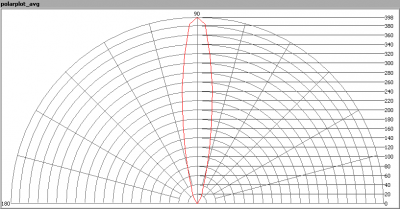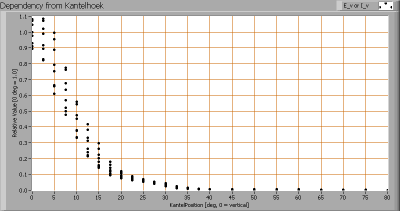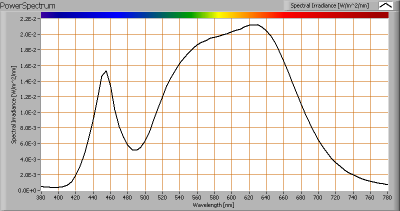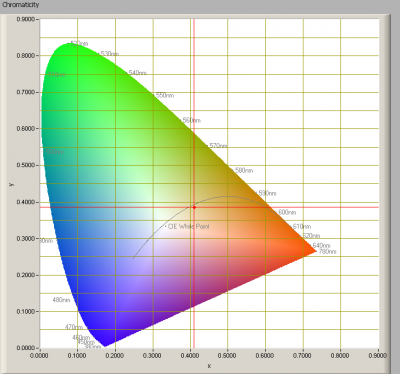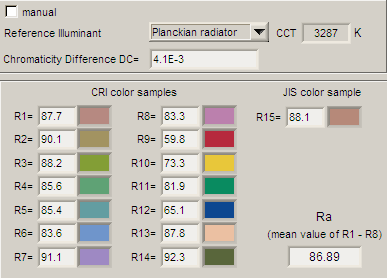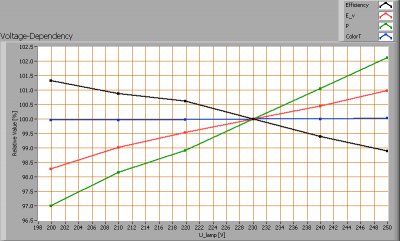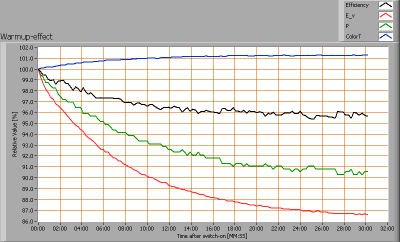Edison Led 3×1 W GU10 WW
Posted by Marcel van der Steen in Led lights, Light measurements No Comments»A lightbulb with a formfactor of a spotlight and a GU10 fitting. This lightbulb comes from Technea Duurzaam, and is for sale at De Energie Bespaarshop. The lamp has a color rendering that is comparable with one of an incandescent lightbulb, and this is positive.
See this overview for a comparison with other lightbulbs.
Summary measurement results
| parameter | meas result | remark |
|---|---|---|
| Color temperature | 3360 K | Between warm white and bright white. |
| Luminous intensity Iv | 404 Cd | This makes a bright light. |
| Beam angle | 18 deg | A focussed beam. |
| Power P | 3.5 W | |
| Power Factor | 0.50 | For every 1 kWh net power consumed, there has been 1.7 kVAhr for reactive power. |
| Luminous flux | 69 lm | |
| Luminous efficacy | 20 lm/W | |
| CRI_Ra | 87 | Color Rendering Index. |
| Coördinaten chromaticity diagram | x=0.409 and y=0.386 | |
| Fitting | GU10 | |
| Diameter | 49 mm | Measured at the widest part of the lightbulb. |
| Length | 56 mm | Including the GU10 fitting feet. |
| General remarks | The ambient temperature during the whole set of measurements was 23.0-24.5 deg C.
Warm up effect: is present. Voltage dependency: almost not present. For all raw measurement data follow this link (edison-led-3×1-w-gu10-ww-30deg.zip). |
E_v at 1 meter distance, or I_v
Herewith the plot of the average Luminous Intensity (I_v) dependent from the inclination angle with the lamp. Average here means that all Luminous Intensities measured with different turn angles but the same inclination angle, are averaged.
The radiation pattern of the lamp.
This radiation pattern shows a focused beam.
The luminous intensity dependent from the inclination angle, now with all turn angle measurements included.
The luminous intensity Iv is decreasing rapidly, to get to its 50 % value at 9 degrees inclination angle. The beam angle of the light from this lightbulb is then 18 degrees.
Looking at the measurement data at inclination angles between 0 and 10 degrees it becomes clear that there are a number of measurement points with different intensity values. These measurements are taken with the same inclination angle, however with a different turn angle. The results differ which indicates that the leds in the bulb are perfectly mechanically aligned.
The plot at the top of this paragraph shows the averaged luminous intensity values per inclination angle, which is used to compute the total luminous flux.
Luminous flux
With the luminous intensity data as a function of the inclination angle, it is possible to compute the luminous flux.
The result of such computation for this lamp is a luminous flux of 69 lm.
Luminous Efficacy
The luminous flux being 69 lm, and the power of the lightbulb being 3.5 W, yields a luminous efficacy of 69 / 3.5 [lm/W] = 20 lm/W.
A power factor of 0.50 means that for every 1 kWh net power consumed, a reactive component of 1.7 kVAr was needed.
| Light bulb voltage | 230 V |
| Light bulb current | 31 mA |
| Power P | 3.5 W |
| Apparent power S | 7.0 VA |
| Power factor | 0.50 |
Color Temperature and Spectral Power Distribution
The spectral power distribution of this lamp.
The measured color temperature is about 3350 K, equivalent to light between warm white and birght white.
Chromaticity Diagram
The chromaticity space and the position of the lamp’s color coordinates in it.
The light coming from this lamp is close to the Planckian Locus (the black path in the graph).
Its coordinates are x=0.409 and y=0.386.
Color Rendering Index (CRI) or also Ra
Herewith the image showing the CRI as well as how well different colors are represented. The higher the number, the better the resemblance with the color when a black body radiator would have been used (the sun, or an incandescent lamp).
Each color has an index Rx, and the first 8 indexes (R1 .. R8) are averaged to compute the Ra which is equivalent to the CRI.
CRI of the light of this lightbulb.
The value of 87 is higher than 80 which is considered a minimum value for indoor usage. Since this lightbulb’s color temperature is less than 5000 K, it is compared with the light of a black body radiator of te same correlated color temperature. When comparing, this light bulb renders the different test colors quite well.
Note: the chromaticity difference is 0.0041 which is lower than 0.0054, which means that the calculated CRI result is meaningful. This is because the chromaticity value of this lamp is close enough to the Planckian Locus.
Voltage dependency
The dependency of a number of lamp parameters on the lamp voltage is determined. For this, the lamp voltage has been varied and its effect on the following lamp parameters measured: illuminance E_v [lx], color temperature CT or correlated color temperature CCT [K], the lamppower P [W] and the luminous efficacy [lm/W].
Lamp voltage dependencies of certain light bulb parameters, where the value at 230 V is taken as 100 %.
There is little dependency from the applied voltage. And the dependency there is, is also linear with applied lamp voltage. It indicates that the used power converter inside the lamp behaves stable.
To check whether this dependency can lead to visible changes in illuminance for possible grid voltage changes, just check what variations occur when the lamp voltage varies around 230 V + and – 5 V. Then the illuminance varies << 20 % and is not visible or noticeable.
Warm up effects
After switch on of a cold lamp, the effect of heating up of the lamp is measured on illuminance E_v [lx], color temperature CT or correlated color temperature CCT [K], the lamppower P [W] and the luminous efficacy [lm/W].
Effect of warming up on different light bulb parameters.
There is an effect of the warming up on the lamp parameters. After half an hour burning the temperature of the light bulb is stable, and the illuminance is about 10 % lower than at switch on.

